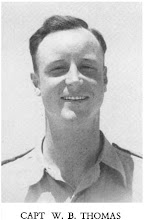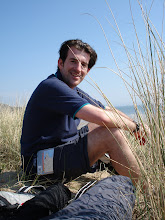We spent last night in a village hall - right next to the church in Kalamoto. The villagers couldn't have been more helpful, even coming to tell us that breakfast was ready back in the square.
Our saviour was a man called Andronikos - a tall, white haired man who was connected with the church. Until his arrival the previous evening, we were on the verge of a night in the open (which wouldn't have been pleasant, as it had been a cold night). Andronikos couldn't have been more helpful, shepherding us to breakfast and sitting close to us as we had a feast. The coffee was good and strong, and we were given cheese, ham and a wonderful jam made of pear, cherry and other fruits.
An old man called Savas had been brought to see us. His father, Haralabos (Harry) had been instrumental in helping Allied troops who came to the area. Savas knew of the kalleva on the edge of the village where two "English" had stayed, and agreed to show us where it had been.
We set off to the eastern end of the village. About a half mile from the older farmhouses is an area of dead ground, leading down to an eroded gully that leads on down to the stream bed that skirts the southern side of the village. As Savas explained, it had been a round enclosure where they had one kept animals. We felt it was a good fit with the description in "Captive Kiwi", and it was clear that Allied troops had been kept here. The area was invisible from the village, and allowed a good escape route down to the stream bed.
After walking the rough ground, we headed back to Savas' farmhouse. It was a rough two-level house, with an external staircase leading up to a balcony over the front door. Beneath the balcony was a wide double door which allowed the animals to be brought in. Savas said that English troops had been hidden in the house and barns by his father, and rushed to bring photographs of his parents for us to see.
After organising our rucksacks, we started our walk east out of the village. Savas followed us in his red pick-up, jumping ahead of us to show the right track. We climbed into the rolling countryside beyond Kalamoto, well grazed grasslands dotted with gorse, with sheep farms every few kilometers. We had a great view towards the low hills and mountains to the south-east.
We arrived at the next village, Marathousa, in time for lunch. We had lunch in the main square with a group of locals - three women (Hrissa, Magdella and Elivthera) told us their fathers had helped English escapers in the village. Another old man joined us - Nikos Koutsos. He had been a boy at the time, and remembered bringing food to English soldiers hiding in the village. He had been part of the resistance network, and knew the location of the mill.
We were taken to the mill by Hrissa, who kept a cracking pace despite her heels. We tramped out of the village, along a sandy track that Hrissa said was the old route to Arnea. The mill was a little way out of the village, down amongst plane trees. The millstones were powered by water piped from a spring further up the hill. We explored around the mill, before bidding goodbye to Hrissa and Andronikos and heading on the scrubby path towards Arnea.
It was already late, and as we chomped the apples that Hrissa had given us the light was already falling. It was a long night over rough country, and Tyson wasn't feeling great. We ended the night in Arnea - it was pitch black by the time we arrived, and thankfully it was safe to stay 68 years later.
Tomorrow we continue on to Ierisos, and our chance for a swim in the sea!
Friday, 30 October 2009
Subscribe to:
Post Comments (Atom)


No comments:
Post a Comment